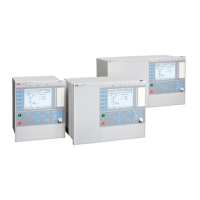implemented in the IED compensates for both the turns-ratio and the phase shift
internally in the software. No auxiliary current transformers are necessary.
The differential current should theoretically be zero during normal load or external
faults if the turn-ratio and the phase shift are correctly compensated. However, there
are several different phenomena other than internal faults that will cause unwanted and
false differential currents. The main reasons for unwanted differential currents may be:
• mismatch due to varying tap changer positions
• different characteristics, loads and operating conditions of the current transformers
• zero sequence currents that only flow on one side of the power transformer
• normal magnetizing currents
• magnetizing inrush currents
• overexcitation magnetizing currents
3.5.1.2 Setting guidelines
The parameters for the Transformer differential protection function are set via the local
HMI or Protection and Control IED Manager (PCM600).
Restrained and unrestrained differential protection
To make a differential IED as sensitive and stable as possible, restrained differential
protections have been developed and are now adopted as the general practice in the
protection of power transformers. The protection should be provided with a
proportional bias, which makes the protection operate for a certain percentage
differential current related to the current through the transformer. This stabilizes the
protection under through fault conditions while still permitting the system to have good
basic sensitivity. The bias current can be defined in many different ways. One classical
way of defining the bias current has been Ibias = (I1 + I2) / 2, where I1 is the
magnitude of the power transformer primary current, and I2 the magnitude of the
power transformer secondary current. However, it has been found that if the bias
current is defined as the highest power transformer current this will reflect the
difficulties met by the current transformers much better. The differential protection
function uses the highest current of all restrain inputs as bias current. For applications
where the power transformer rated current and the CT primary rated current can differ
considerably, (applications with T-connections), measured currents in the T
connections are converted to pu value using the rated primary current of the CT, but
one additional "measuring" point is introduced as sum of this two T currents. This
summed current is converted to pu value using the power transformer winding rated
currents. After that the highest pu value is taken as bias current in pu. In this way the
best possible combination between sensitivity and security for differential protection
function with T connection is obtained. The main philosophy behind the principle with
the operate bias characteristic is to increase the pickup level when the current
1MRK504116-UUS C Section 3
IED application
99
Application manual

